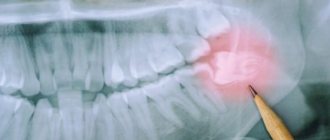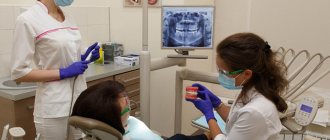No one doubts that every tooth in the mouth is important. The only exception is the “eight”. Their absence does not cause any functional disorders, does not affect the aesthetics of a smile or the ability to chew food. All other teeth are necessary so that the dentofacial apparatus can work as a single coherent mechanism.
With the help of incisors we bite off food, canines and premolars are used to grab food, molars are used to crush and grind food. The loss of any of these teeth inevitably leads initially to discomfort, various functional inconveniences, and later to deformation of the dentition.
Increased load on other teeth
In the absence of any teeth, their function is taken over by neighboring teeth, and accordingly, the load on tooth enamel, crowns and roots increases significantly. This leads to the fact that teeth begin to deteriorate many times faster. For example, when removing molars, the incisors have to take on a task not provided for by nature - grinding food. As a result, longitudinal and transverse cracks appear on the enamel, the edges of the teeth wear off and turn yellow.
Increased load over time turns out to be fatal for the roots, as it provokes their increased mobility. If you do not reduce the constant pressure, bone tissue will also begin to suffer from overload.
What complications can there be?
The complete absence of teeth inevitably causes psychological problems, functional discomfort and quite dangerous consequences for the entire body:
- problems associated with eating: the inability to bite and chew food normally leads to serious diseases of the digestive tract,
- gingival subsidence and bone tissue atrophy, which causes difficulties in prosthetics,
- deformation of the shape of the face, the appearance of wrinkles, reduction of the lower third of the face, retraction of the lips into the oral cavity. If all teeth are missing, a person looks much older than his age.
Bone loss
After a tooth is removed, the bone tissue begins to atrophy. Bone volume decreases by 25% per year, and the process is not as harmless as it might seem at first glance. Bone atrophy can cause adjacent teeth to become loose and even fall out.
Bone loss also creates problems with subsequent prosthetics. If a tooth is missing for too long, doctors have to perform a bone grafting procedure before installing an implant. This significantly increases the overall treatment time and cost.
Causes of tooth loss
- Periodontal diseases (may be a consequence of general disorders of the body)
- Caries and its complications (pulpitis, periodontitis)
- Injury
- Other reasons
The main motivation for dental treatment in patients with tooth loss, regardless of the cause and scale of the problem, are:
- decreased smile aesthetics
- loss of chewing efficiency
Diagnostics is the first and key step in the treatment of tooth decay and loss. Do you want to know why it’s impossible to do without diagnostics?
But, in fact, the loss of even one tooth, in addition to a banal deterioration in the quality of chewing food, can lead to a number of not obvious at first glance, but very serious and global problems. Because, one way or another, it will lead to disruption of the biomechanics of the entire human body.
Normally, if all the teeth are present in the mouth, at the moment of closure, the muscles that lift the lower jaw press it against the upper jaw. The force developed by the muscles through the upper jaw and temporomandibular joint (TMJ) is further distributed throughout the entire skull.
In this case, the general vector of muscle effort is located in the middle of the upper jaw, at the level of the first upper molars. Under such conditions, the main part of the muscle effort (about 70%) will be on the chewing teeth, and a smaller part (about 30%) will be on the TMJ area.
But when the teeth are closed, it is not only the muscles that elevate the lower jaw that contract. To create a balance of forces exerted by the muscles on the skull, the muscles of the neck, the muscles of the suboccipital region and many other muscles also contract. Along the chain, from top to bottom, to the very feet. And the integrity (when all the teeth are in the mouth) and symmetry of the dentition make it possible to maximally balance the above-described muscle efforts.
During a direct examination by a specialist, you will be able to find out your exact diagnosis, as well as receive a referral for diagnosis or a treatment plan.
According to statistics, the first molars (6th teeth) are most often removed, because... They are the first of the permanent teeth to erupt. And, accordingly, they are the first to be exposed to the aggressive effects of the oral cavity and the development of the carious process. Due to their location, these teeth are the main support for the lower jaw when the teeth are closed. And in the absence of these teeth, the muscle balance when closing is disrupted. The main part of the force from the masticatory muscles begins to be distributed to the TMJ, leading to its functional overload with the subsequent development of a pathological process in it. The teeth remaining in the oral cavity also experience overload, because... anatomically not adapted to bear the excess load redistributed to them. This will be manifested by the formation of wedge-shaped defects on the remaining teeth, exposure of the necks of these teeth, atrophy of the bone tissue around them, and pathological abrasion of their enamel.
If we take a hypothetical absolutely symmetrical person with full dentition, then when his teeth are closed, the effect of the muscles that lift the lower jaw on the skull will be balanced by the muscles of the neck, suboccipital muscles, etc.
The ideal distribution of chewing load with full dentition (a complete set of teeth) stabilizes posture.
In the absence of the masticatory group of teeth on one side, the masticatory muscles of that side will contract more strongly in order to bring the lower jaw on that side into contact with the upper. To counterbalance this force, the neck muscles on that side will also contract more forcefully, causing the head to tilt and the shoulder to rise on that side. This asymmetry will spread further down the body all the way to the feet.
The consequences of this asymmetry for the body are very dire. Starting from various pain syndromes due to overload of overly tense muscles and ending with irreversible structural changes in the form of herniated intervertebral discs.
In the absence of a chewing group of teeth on one side, an imbalance in the muscle balance will lead to the development of asymmetry of the entire body - scoliosis.
Lack of proper support in the posterior region will lead to overload of both TMJs and the remaining teeth. Trying to balance the symmetrically increased forces of the masticatory muscles, the muscles of the back of the neck will contract intensely, which will lead to the formation of a forward position of the head, which is fraught with the development of headaches (due to pinching of the suboccipital nerve), impaired cerebral circulation (due to pinching of the vertebral arteries) and etc.
Bilateral symmetrical absence of the chewing group of teeth will lead to a violation of the symmetry of the body in the anteroposterior direction.
Wear of the remaining teeth and degenerative changes in the TMJ area will eventually lead to a posterior displacement of the lower jaw, which can lead to compression of the upper respiratory tract, especially at night (sleep apnea syndrome).
All these consequences do not develop instantly, but over time. And therefore they can form relatively unnoticed. However, it should be understood that the longer this situation persists, the more difficult it is to reverse it. Long-term persistence of muscle imbalance caused by missing teeth can lead, as previously mentioned, to irreversible anatomical changes in the body. Moreover, if this condition exists for a long time, its complications can acquire a character independent of the original cause. In other words, if this imbalance is eliminated in a timely manner, all changes in the body caused by it will be eliminated automatically over time. If you seek help later, eliminating these complications will require additional efforts.
Timely, rational prosthetics of missing teeth will avoid these irreversible consequences and reduce the time and money required for rehabilitation. Advanced cases (cases of long-term absence of teeth) require the mandatory participation of non-dentist specialists, who will have to eliminate the persistent consequences of the described pathological process that have arisen in the body.
Orto-Artel specialists have extensive experience in the treatment and rehabilitation of patients with partial or complete loss of teeth. Including those who have developed the complications described above. After all, it is an integrated, holistic approach and joint thoughtful efforts of dentists, general practitioners and chiropractors, based on clear diagnostics and analysis of the data obtained, that allow us to solve problems of dental prosthetics of any degree of complexity.
Missing part of teeth
If several teeth are lost, they can be replaced with dentures made of plastic or nylon, clasps and bridges. Dental prosthetics using implants installed in the jaw is considered extremely reliable. The latter method also provides the most aesthetic results. When implanting into the body of a bone, the validity period of the inserted implants is maximum; the adjacent teeth do not have to be ground down, which is necessary when using prosthetics with bridges. A dental prosthesis placed on an implant implanted into the bone is quite functional, and from an aesthetic point of view, it completely replaces the lost tooth.
The link between dental and heart health
Dental disease and inflammation in the mouth increase the risk of bacterial infection in the bloodstream, and this, in turn, has a negative impact on the heart valves.
Atrial fibrillation, or atrial fibrillation, is considered the most common form of cardiac arrhythmia in the world, and the condition typically involves an abnormal heart rhythm (most commonly tachycardia, a rapid heartbeat). Possible consequences of atrial fibrillation include thromboembolic disease and heart failure. Scientific research has shown that various inflammatory processes in the body, including inflammation that occurs in the oral cavity, play an important role in how atrial fibrillation begins and progresses in patients.
Methods for restoring missing teeth
The modern level of development of dentistry in almost all cases of violation of the integrity of the dentition makes it possible to solve the problem taking into account all the wishes of the patient. Types of prosthetics:
- Removable dentures. They are necessary if most of the teeth are lost or all of them are missing.
- Fixed. Their use is possible if 1-2 teeth are missing or their main part is destroyed.
- Implantation. This method of prosthetics involves implanting an implant into the bone tissue, onto which a crown is subsequently placed. Implantation is considered the best method of prosthetics, as it returns the desired functionality to the dentition.
The type of prosthetics is selected together with the doctor, taking into account all indications and contraindications.
Research results
Oral disease has been considered a possible cause of heart disease for many years. Modern research has shown that poor oral health and gum disease (such as periodontitis) are associated with an increased risk of developing heart disease. Periodontitis is a disease caused by a bacterial infection, which has a systemic effect on the body due to a constant, low-grade inflammatory process and leads to tooth loss.
Thus, there is a close relationship between the condition of the oral cavity and the health of the cardiovascular system. Scientists note that tooth loss is a sign of serious health problems that extend beyond the oral cavity. For example, a systematic increase in blood pressure (hypertension) over time leads to changes in the blood supply to the gums and, as a result, to tooth loss.
Regardless of diet, physical activity, weight and other risk factors such as hypertension, high blood cholesterol and diabetes, people who lost multiple teeth were at increased risk of developing cardiovascular disease.
The authors also noted that patients who visited the dentist at least once a year had a lower chance of developing cardiovascular disease compared to patients who did not promptly treat their oral problems. After analyzing the data, scientists concluded that for every tooth lost, the risk of cardiovascular disease increases by 6%.
In addition, studies have also shown that older people, smokers, women (especially those with many children) and people with diabetes and hypertension are more likely to experience tooth loss.











